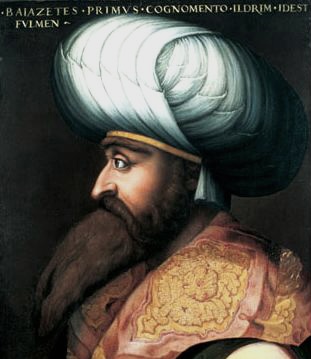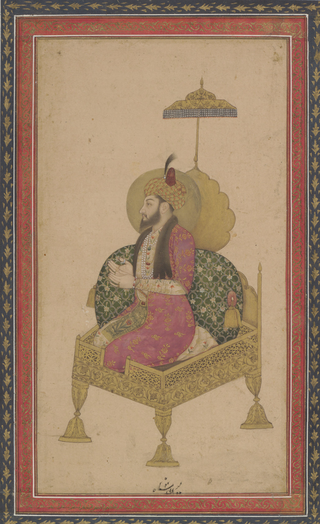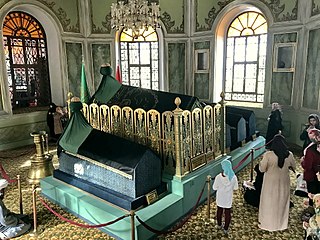
Bayezid I, also known as Bayezid the Thunderbolt, was the sultan of the Ottoman Empire from 1389 to 1402. He adopted the title of Sultan-i Rûm, Rûm being the Arabic name for the Eastern Roman Empire. In 1394, Bayezid unsuccessfully besieged Constantinople. He defeated the Crusaders at the Battle of Nicopolis in what is now Bulgaria in 1396. He was later defeated and captured by Timur at the Battle of Ankara in 1402 and died in captivity in March 1403, which triggered the Ottoman Interregnum.

The Battle of Ankara or Angora was fought on 20 July 1402 at the Çubuk plain near Ankara, between the forces of the Ottoman sultan Bayezid I and the emir of the Timurid Empire, Timur. The battle was a major victory for Timur, and it led to the Ottoman Interregnum.

Mirza Jalal-ud-din Miran Shah Beg, commonly known as Miran Shah, was a son of the Central Asian conqueror Timur, founder of the Timurid Empire.

The Sarbadars were a mixture of religious dervishes and secular rulers that came to rule over part of western Khurasan in the midst of the disintegration of the Mongol Ilkhanate in the mid-14th century. Centered in their capital of Sabzavar, they continued their reign until Khwaja 'Ali-yi Mu'ayyad submitted to Timur in 1381, and were one of the few groups that managed to mostly avoid Timur's famous brutality.

George VII of the Bagrationi dynasty, was king (mepe) of Georgia from 1393 to 1407. George put up a stiff resistance and had to spend much of his reign fighting against Timur.
Sultan Ahmad was the ruler of the Jalayirid Sultanate, he was son to the most accomplished ruler of the sultanate, Shaykh Uways Jalayir. Early in his reign, he was involved in conflicts with his brothers. He would later suffer from several defeats with Timur and eventually imprisoned by the Mamluks. After being set free, he attacked his old enemy, the Qara Qoyunlu but was later captured and executed 1410.

The Timurid invasions of Georgia were eight invasions between 1386 and 1403 of the Kingdom of Georgia in the Caucasus by the Timurid Empire. Led by Timur, the Timurids ultimately conquered Georgia and made it a tributary state. However, Georgia, a Christian monarchy, was allowed to retain its independence and remain Christian.
Qutb al-Din Muhammad was the Mihrabanid malik of Sistan from 1403 until his death. He was the son of Shams al-Din Shah 'Ali.

Amir Sultan or Emir Sultan was a well-known thinker in the world of Islam and mysticism (tasawwuf), who lived in Bursa during the early period of the Ottoman Empire. He was Amir Kulal Shamsuddin's grandson.

Timur or Tamerlane was a Turco-Mongol conqueror who founded the Timurid Empire in and around modern-day Afghanistan, Iran, and Central Asia, becoming the first ruler of the Timurid dynasty. An undefeated commander, he is widely regarded as one of the greatest military leaders and tacticians in history, as well as one of the most brutal and deadly. Timur is also considered a great patron of art and architecture as he interacted with intellectuals such as Ibn Khaldun, Hafez, and Hafiz-i Abru and his reign introduced the Timurid Renaissance.
Lakia is an ancient ethnic region within the state of Dagestan. Its historical capital is Kumukh, one of the ancient cultural and religious centres of Lakia. The people of Lakia are self-designated as Laks and their native language is Lak.

"Gazikumukh Shamkhalate" is a term introduced in Russian-Dagestan historiography starting from the 1950s–60s to denote the Kumyk state that existed on the territory of present-day Dagestan in the period of the 8th to 17th centuries with the capital in Gazi-Kumukh, and allegedly disintegrated in 1642. However, In the 16th century's Russian archival sources Tarki is stated to be the "capital of Shamkhalate" and "the city of Shamkhal", while "Kazi-Kumuk" is mentioned as a residence. These facts contradict "1642 disintegration" date. Moreover, there is absolutely no source before the 1950s containing the term "Gazikumukh Shamkhalate" or a statement that Gazi-Kumukh had ever been the capital of Shamkhalate. Historically, Shamkhalate is widely described as Tarki Shamkhalate or just Shamkhalate.

The Shamkhalate of Tarki, or Tarki Shamkhalate was a Kumyk state in the eastern part of the North Caucasus, with its capital in the ancient town of Tarki. It formed on the territory populated by Kumyks and included territories corresponding to modern Dagestan and adjacent regions. After subjugation by the Russian Empire, the Shamkhalate's lands were split between the Empire's feudal domain with the same name extending from the river Sulak to the southern borders of Dagestan, between Kumyk possessions of the Russian Empire and other administrative units.
Gazikumukh Khanate was a Lak state that was established in present-day Dagestan after the disintegration of Gazikumukh Shamkhalate in 1642. Its peoples included various Lezgin tribes and Avars.

Simsim was either a historical region or kingdom in the North Caucasus during the Middle Ages, existing in the 14th century. Predominantly localized roughly in Eastern Chechnya (Ichkeria), with some also connecting part of Kumyk Plain. Simsim is also localized in both Chechnya and Ingushetia. Its name may have been derived from the Chechen village of Simsir. However, according to folklore, the King Gayur-khan was chosen as the leader of all Chechens by the Mehk-Khel. In its later years it allied itself with the Golden Horde before being destroyed in 1395 by Timurlane, which was recorded in Zafarnama by Nizam al-Din Shami and the Zafarnama by Sharaf ad-Din Ali Yazdi.

The Timurid conquests and invasions started in the seventh decade of the 14th century with Timur's control over Chagatai Khanate and ended at the start of the 15th century with the death of Timur. Due to the sheer scale of Timur's wars, and the fact that he was generally undefeated in battle, he has been regarded as one of the most successful military commanders of all time. These wars resulted in the supremacy of Timur over Central Asia, Persia, the Caucasus, the Levant, and parts of South Asia and Eastern Europe, and also the formation of the short-lived Timurid Empire. Scholars estimate that his military campaigns caused the deaths of 17 million people, amounting to about 5% of the world population at the time.
Sultan Husayn Tayichiud was a noble of the Timurid Empire and a maternal grandson of its founder, the Central Asian conqueror Timur. Sultan Husayn held prominent positions in the Imperial army and accompanied his grandfather on several of his military campaigns. He was executed by his uncle Shah Rukh during the war of succession following Timur's death.
The Chechen–Kazikumukh war, also known as Chechen reconquista or Z'okk-K'ant's campaign against the Kazikumukhs, was a war between Chechens and the Laks of Gazikumukh Shamkhalate, the Kabardians and the Kalmyks in the 16th century. The war began as a result of Chechens from Nashkh region resettling around the Kazikumukh controlled area of T'sontaroy and refusing to pay tribute to the Kazikumukhs. The war lasted 10 years, defeating the Kazikumukh in 3 years, and conflict with the Kalmyks and Karbardians continued for 6 more years, both ending with the Chechens reconquering former lands of Aukh and Nokhchmokhk, continuing until the shoreline of the Caspian Sea and pushing the Kalmyks beyond the Terek (river).The Kazikumukh, worrying that the Chechens will continue to conquer more lands, sent a messenger to Sulak (river) in order to reach an agreement with the Chechens. As a result the Chir-Yurt peace treaty was signed and one of the Shamkals sons was offered to the Chechens as an amanat (hostage).
During the Main Timurid campaign against Simsim in 1395, the main Simsim army, led by Khour II as well as other Chechen nobles clashed with the Timurids led by Timur. The battle resulted in the defeat of the former.
The Sack of Bhatner Fort (1398) was an siege led by Timurid Empire in (1398) during the Invasion of Dehli. Timur laid siege on Bhatner Fort with an army of 10,000 troops against the Muslims and Rajputs of Rajasthan. It took place on 23 November 1398 in Rajasthan and ended with a Timurid victory.











